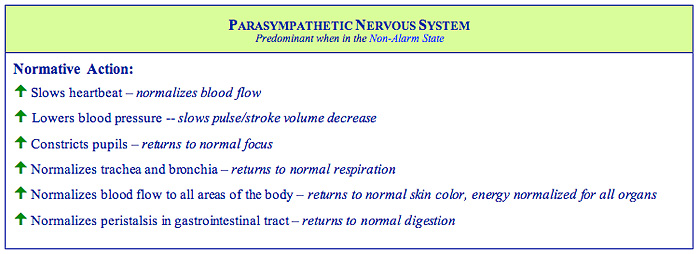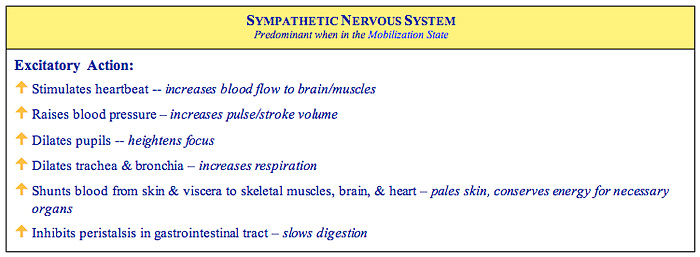
The Method
The Role of Autonomic Reflexes
While somatic reflexes are visibly apparent given the role they play in generating motor responses that allow us to interact with the outside environment, autonomic reflexes are generally far less apparent given the unconscious nature within which they manage vital internal functions. Few people are aware of the emotional and behavioral impact this internal, quietly managed system has on our ability to deal with familiar, novel, or threatening changes in our environment.
The autonomic nervous system is divided into four subsystems:
1. The parasympathetic nervous system
2. The sympathetic nervous system
3. The subsystem managed by the non-myelinated vagus nerve
4. The enteric nervous system
The current understanding of these four subsystems incorporates research findings of a number of scientists, each building on the work of the next, to broaden understanding regarding the role played by the autonomic system. Summarized below are the scientists most often associated with revealing the nature of the autonomic nervous system, along with bulleted points relating to their main contributions. To learn more, click on the name of interest for a more in depth summary.
- First to observe and articulate scientific evidence of the constant nature of the milieu interieur (internal environment) of the body.
John Newport Langley: 1852-1925
- Identified the basic structure of the autonomic nervous system.
- Isolated three autonomic subsystems, the parasympathetic, sympathetic, and enteric systems, and determined the basic internal functions managed by each
- Observed and articulated a paired antagonistic relationship between the parasympathetic and sympathetic systems
- Demonstrated the autonomic nervous system could function independent of the central nervous system using chains of ganglia (Groups of nerve cell bodies that run along the spinal cord) and plexus ganglia (large concentrations of nerve cells) inside vital organs to coordinate and direct internal autonomic function.
- Identified the alarm state response system associated with the sympathetic nervous system and the non-alarm state response system associated with the parasympathetic system and the symbiotic relationship existing between the sympathetic and parasympathetic systems to engage more or less one of these states.
- Coined the phrase “fight and flight”
- Building on the earlier work of Claude Bernard and his own alarm state work, scientifically validated the homeostatic nature of autonomic reflexes in the body.
- Demonstrated the biological impact of a prolonged alarm state on the body
- First to use the word ‘stress’ in relationship to the impact of novel changes in the environment on the body.
- Proposed the General Adaptation Syndrome to explain the impact of stress on the body.
- Highlighted that stress in and of itself was a neutral term that could be either positive, motivating, focusing and energizing a person to resolve challenging assignments, projects, or situations; or negative when the body is not allowed to intermittently restore itself.
- Coined the term “eustress” to refer to positive stress.
- Broadened Langley’s model of the autonomic nervous system demonstrating that the central nervous system, and not just the autonomic chains of ganglia and plexus, is also involved in managing autonomic function, winning a Nobel Prize for his work in this area in 1949.
Until Hess, many assumed because the autonomic system could function without the coordination and direction of the central nervous system that it did function without the central nervous system. Regardless, without the contributions of both men, the more complete picture would not have been revealed.
Stephen Porges: 1945 – to present
- Broadened the work of Langley and Hess revealing a fourth subsystem within the autonomic nervous system responsible for triggering the body’s immobilization behaviors.
- Associated control and management of interactive facial reflexes (eye contact, expressive engagement) and auditory prosody with the parasympathetic system.
- Formulated the Polyvagal Theory to explain the integrated behavioral adaptation strategy used by the body to engage social interaction, restoration, and growth through the parasympathetic system; mobilize the body for near-term action through the sympathetic system; or immobilize the body to ensure immediate preservation through the system managed by the non-myelinated vagus nerve.
The Symbiotic Nature of Autonomic Subsystems
The autonomic nervous system performs a number of activities automatically without any need for conscious effort. These include breathing, beating of the heart, peristalsis in the digestive system and other functions that need to be carried out without interruption to ensure survival. The earlier work of Langley, Cannon and Selye led many to popularize the idea that the sympathetic system (dominant control during non-alarm state) and parasympathetic system (dominant control during alarm state) are antagonistically paired, with one being on while the other is off. While this general characterization accurately reinforces the general role filled by each of these subsystems, it is more accurate to characterize the association as symbiotic. In fact, taking into account the recent findings of Porges regarding the role of the non-myelinated vagus nerve in immobilization, it becomes clear that all three of these autonomic subsystems work together to ensure internal resources are moderated and coordinated to instill one of three general states of alarm in the body.
1. Non-Alarm State Which fosters calm and optimizes internal conditions to support:
- Restoration
- Social engagement
- Growth
2. Mobilization State Which readies the body for action and optimizes internal conditions to support:
- Focus and advance in response to normal life challenges, or
- Fight and flight in response to potential danger.
3. Immobilization State Which stills the body’s vital functions to a minimum to optimizing internal conditions to support preservation through:
- Pause to fulfill normal life-sustaining imperatives, or
- Freeze to ensure immediate survival in response to sudden, unexpected life threatening event.
Through this resource allocation the autonomic subsystems work together to conserve and redirect resources to optimize performance, minimize waste and allow the body to effectively and efficiently address environmental changes whether familiar and non-threatening, novel and potentially dangerous, or vital and potentially life threatening.
Parasympathetic System & Non-Alarm State Reflexes
The parasympathetic nervous system manages non-alarm state reflexes in the body. A general non-alarm state is engaged in the body when changes in the environment (or general environmental conditions) are familiar and non-threatening. The role of the parasympathetic system is to ensure long-term survival by maintaining the body’s vital functions through ongoing homeostasis. Additionally, when the body needs to recover from the mobilization state of the sympathetic system or the immobilization state of the system managed by the non-myelinated vagus, the parasympathetic system acts to replenish reserves to ensure the body is prepared the next time mobilization or immobilization states are engaged. Recent work by Stephen Porges has revealed that in addition to restoration and homeostasis, the parasympathetic system also regulates muscles in the face and head, resulting in a “coupling between social engagement behaviors and bodily states.” (Porges, 2008) All of these things combined help to foster calm in an individual’s system and help to support physical, emotional, behavioral, social and cognitive growth. Examples of parasympathetic reflex responses are summarized in the following table. A more complete list of parasympathetic reflexes is included in our ‘Reflex Examples’ section.

The Sympathetic System & Mobilization
The sympathetic nervous system is responsible for mobilizing the body for action. The mobilization state is automatically triggered when the body faces novel, unexpected, or potentially dangerous changes in the environment. The role of the sympathetic nervous system is to ensure near-term survival by engaging functions in the body that allow a person to focus and advance when faced with challenging situations, events, or tasks, or to fight or flee when faced with potential danger. Assuming normal function, the magnitude of the situation, event, or task will determine the degree to which the sympathetic nervous system engages.
Typical life-challenging events that could trigger focus and advance include:
- Preparing your first thanksgiving dinner for your new husband and his family
- Studying for a test
- Participating in a sports competition.
Typical, potentially dangerous events that could trigger fight or flight include:
- A warm shower suddenly turning ice cold
- An unexpected scream in the next room
If the autonomic nervous system is functioning as it should, the sympathetic system will quickly mobilize to address novel changes in the environment whether dangerous or simply challenging, effectively and efficiently resolving the various challenges faced in the course of living. Examples of sympathetic reflex responses are summarized in the table below. A more complete list of sympathetic reflexes is included in our ‘Reflex Examples’ section
 .
.
The Non-Myelinated Vagus Nerve & Immobilization
Steven Porges through comparative research was able to trace control of the immobilization state in the body to the non-myelinated vagus nerve. Porges determined that the immobilization state is automatically triggered when the body faces vital, potentially life-threatening changes in the environment. The role of the immobilization system is to ensure immediate survival by engaging functions in the body that either allow it to pause without fear minimizing internal functions to the absolute minimum so that the necessary natural process can unfold as needed to allow the body not only to survive, but to re-boot after the experience, re-vitalized and ready to productively re-engage, or to freeze with fear when faced with a truly life-threatening situation. Examples of events that should trigger pause without fear include falling asleep or a newborn baby when breastfeeding. Examples of events that should trigger freeze, stilling the body to minimize harm and allow it to survive include the birth process for both the newborn and the mother, or truly life-threatening events.
The Role of the Enteric System
The enteric system manages the digestive system. While the sympathetic and parasympathetic systems can and do impact the function of the digestive system, it is often viewed as a distinct, separate system because of its ability to function even when it is entirely cut off from the rest of the nervous system. While the ability of the digestive system to function separately is important, any additional perspective we provide regarding its function will be within the context of the parasympathetic and sympathetic nervous systems.


